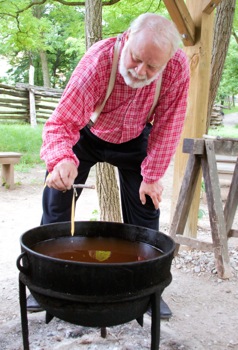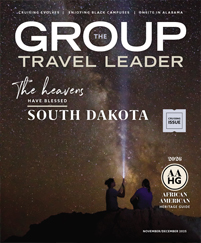
Churning butter, gathering eggs, buying candy from large barrels in a general store stocked with 19th-century items, riding in a canal boat pulled by a team of horses, dipping candles, making soap and even shearing sheep: These time-capsule experiences are available at several living-history sites in the Heartland, among them Indian villages, pioneer farmsteads, historic forts and 19th-century crossroads villages.
Have your group store their cell phones and laptops on the bus and let their imaginations take then back in time as they visit these sites for entertaining and educational experiences.
Conner Prairie
Fishers, Ind.
Conner Prairie, near Indianapolis, features a wide range of first-person interaction and hands-on activities that portray 19th-century life in Indiana.
“Our primary experience area is an 1836 village that uses first-person interpretation where the staff dressed in costume actually portray people living in the year 1836,” said Dan Freas, vice president of guest experience at Conner Prairie. “As people interact with the staff, they speak and work and do everything as if the folks had stepped back in time to 1836.”
Visitors are encouraged to interact with the staff and take part in the daily activities, whether it is negotiating with a fur trader at an Indian village, sweeping a front porch, dipping a candle or baking a pie on a wood-burning stove.
A modern welcome center provides a good introduction to the 200-acre complex, which includes a Lenape Indian camp; 1836 Prairietown; the William Conner Homestead, the restored brick home of one of the area’s original settlers; and the 1859 Balloon Voyage, which gives rides 350 feet up in a tethered helium balloon to replicate a mid-19th-century experiment.
The 1886 area known as Liberty Corner is currently under construction and will reopen in the spring as a different historic period and a whole new experience that will be announced later this year.
There are numerous interactive and behind-the-scenes options for groups, many of which are exclusive, and they can be customized to a group’s interest. “If a group has a specific interest, we try to accommodate it,” said Freas.
Groups can also arrange for a period meal in the welcome center. “Groups usually are here long enough [that] they want to get something to eat anyway,” said Freas. “The meal is based on recipes from the 19th century. It is a wonderful way to incorporate a meal into the larger experience.”
Old World Wisconsin
Eagle, Wis.
“We are a pretty large site, with 576 acres and 10 working farmsteads representing a lot of the ethnic immigrants to Wisconsin — Norwegian, German, Finnish, Danish,” said Lisa McGovern, marketing and communications director for Old World Wisconsin, located in southeastern Wisconsin between Milwaukee and Madison.
“We have costumed interpreters who go about the work, chores and play of the people of the time, from the late 1800s to the early 1900s. On a day-to-day basis, as the people go about their work, we invite visitors to help out.
“For groups, we can arrange special things, such as a talk with a curator,” said McGovern. “For example, if a group is very interested in gardening, our historic gardener can talk about the 12 heirloom gardens we have.”
Crossroads Village, a re-creation of an 1870s rural village, also illustrates Wisconsin’s European diversity with costumed interpreters who portray professions, such as a Welsh shopkeeper, an Irish laundress, a Norwegian wagonmaker and a Bohemian shoemaker.
“We also have vintage baseball in authentic wool uniforms that go back to the 1860s,” said McGovern. “After games, we invite visitors to try the balls and bats.”
Trams take visitors among the farmsteads. An orientation center with an introductory movie is in a historic barn, and there’s a restaurant at the other end of the village green.
The more than 60 historic buildings were dismantled from sites throughout the state and painstakingly reconstructed at Old World Wisconsin.
www.oldworldwisconsin.org
Living History Farms
Urbandale, Iowa
When William Murray founded Living History Farms 40 years ago, “he didn’t want to just showcase things under glass,” said Jennie Deerr, publicity coordinator for the farms, located in suburban Des Moines. “He thought you should have a truly living museum where people could interact, see, smell and touch what it was like. That is what we have today.”
Living History Farms consists of three working farms on 500 acres — a 1700 Ioway Indian site, an 1850 pioneer farm and a 1900 horse-power farm — along with an 1875 town, Walnut Hill.
“We cover 300 years of agriculture history,” said Deerr. “We show where food comes from and how the prairie was converted to what we have today.
“We have historic interpreters at each site in period-appropriate clothing. They are there not only to re-create — they do farm just as the specific time period represents — but also interact with visitors.
“They tell what it would have been like in that time period and very often let visitors help with various farm chores; they make it hands-on for the visitors.”
For example, Deerr said that at the 1900 farm, visitors can gather eggs or help put up hay.
For more beaches: Group-friendly beaches: Shoes optional WEB EXCLUSIVE! Wildwoods beach rocks and rolls WEB EXCLUSIVE! 5 more beach havens
“They will put the hay on a wagon, and it will go up into the hayloft. It is cool to watch.
“You can help with gardening and do activities such as candle dipping, soapmaking and butter churning. We really try to get the visitor involved.”
Tractor-pulled trams take visitors to the farms from the village. A short orientation and a map are at the visitor center.
www.lhf.org
Roscoe Village
Coshocton, Ohio
In the 1830s, when canals were the interstate highways carrying passengers and cargo to America’s interior, Roscoe Village, Ohio, was a bustling commercial center on the Ohio-Erie Canal.
Although long bypassed by railroads and modern paved highways, Roscoe Village’s heyday is lovingly preserved in both restored and replicated buildings.
“We have interpreters in the buildings on weekends and costumed guides during the week,” said Debbie McDonald, marketing and public relations manager for the restored village in Coshocton County, 90 miles east of Columbus. “We have a blacksmith, a broommaker, a weaver and a printer. We have a doctor in the doctor’s office, and Mrs. Johnson is in the doctor’s house. We have a one-room schoolhouse.”
The village has 15 shops selling garden items, jewelry, kitchen accessories, candles, wine and distressed furniture made to look old. “The Roscoe General Store carries a magnitude of things, and the girls in there dress in costume,” said McDonald.
The visitor center sells handcrafted items made by the village’s artisans, including candleholders, wooden toys, weavings, rolling pins and other wood items. Its exhibit hall has dioramas about the canal era and models of the canal locks and a gristmill.
“We also have horse-drawn canal boat rides,” said McDonald. “The horses walk a tow path on a restored section of the Ohio-Erie Canal. The narrated tour covers about a mile in 45 minutes; they talk about who traveled the canal, what was brought in, how they did it and how they opened the locks.
“A lot of coaches like the one-hour tour, Roscoe Bits and Pieces, which features four buildings, and we can do an 1800s trade tour in the exhibit hall where we demonstrate weaving and coopering (barrelmaking) and tell about the canal’s history.”
The village’s restaurants include a full-service restaurant in an old warehouse and a wine-and-coffee bar that serves light lunches.
www.roscoevillage.com
Historic Fort Snelling
Minneapolis
When Fort Snelling was built in the 1820s at the confluence of the Minnesota and Mississippi rivers in south central Minnesota, it was the northernmost outpost of the U.S. Army.
“It was built on a high bluff above the rivers to basically look after the fur trade,” said Tom Pfannenstiel, site manager for Historic Fort Snelling, “and was just across the Mississippi River from the original headquarters of the American Fur Co.”
Although the fort went through several incarnations and had several ups and downs over more than a century of operation, Pfannenstiel said its heyday was from about 1825 to 1858, roughly the period interpreted in the reconstructed 40-acre fort operated by the Minnesota Historical Society.
“The fort is comprised of about 18 buildings and the walls of the fort,” said Pfannenstiel. “Four buildings are original; the rest were reconstructed in the late 1960s and early 1970s.
“We normally have 19 people in costume and depict everything from Colonel Snelling and his wife in the commanding officer’s house to soldiers and the things they would be doing, such as marching and firing muskets and cannons. We have a surgeon in the hospital, a blacksmith and someone in the bake shop.”
Pfannenstiel said the interpreters also talk about Dred Scott and his wife, who lived at the fort as slaves of an officer. “Officers brought slaves here, although it was a free state,” he said.
Although the interpretation focuses largely on the mid-19th century, Pfannenstiel said there is also discussion of the fort’s role as a large training center during the Civil War, the Spanish-American War and the two world wars.
Several special events are held throughout the year, including World War II, Civil War and harvest weekends. The costumed interpreters are there daily during the summer and on weekends in May, September and October.
For more America’s heartland:
Cuisine that makes it good to be hungry
Agritourism’s harvest
Get hip to the urban heartland
Conner Prairie
Elkhart County’s Amish haystack
Agritourism on the cusp of suburbia
Tasting the Old World









